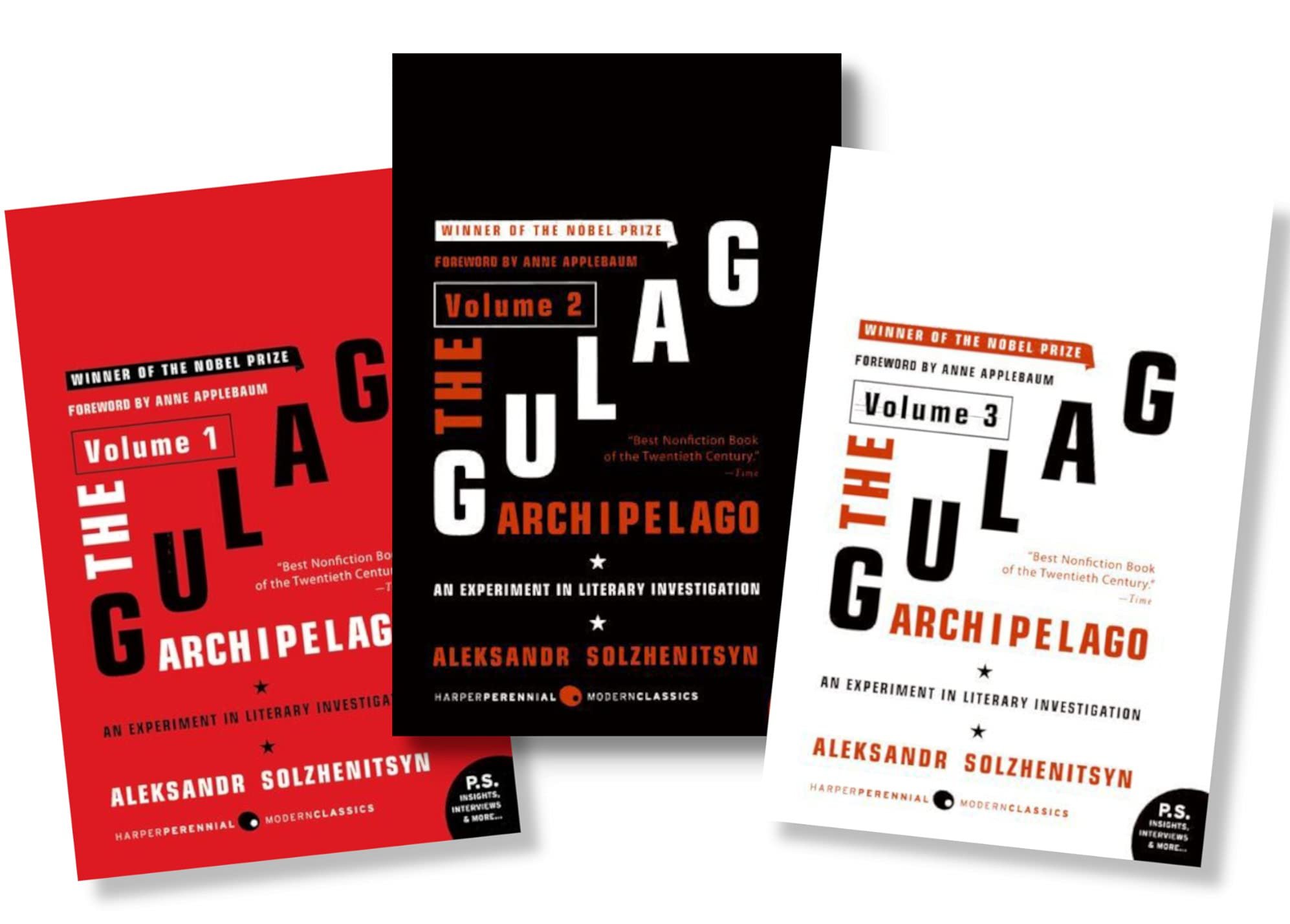Large Works & Novels > The Gulag Archipelago
The Gulag Archipelago
1918-56: An Experiment in Literary Investigation
The publication of One Day in the Life of Ivan Denisovich in 1962 seemed to have broken a dam. The writer was stunned by the response:
“There were letters to me, hundreds of them!. . . . It was an explosion of letters from the whole of Russia, one that could not possibly be contained in any single breast. It provided a vantage point for an overview of zek lives, a subject previously quite beyond reach. Biographies, events, and episodes kept unfolding before me one after the other.”
Given these circumstances, it is hardly surprising that Solzhenitsyn came to look upon the writing of The Gulag Archipelago as an ineluctable moral duty, and went on to become the acknowledged chronicler of a nation’s misfortune.
But it was difficult to hit upon a method of shaping the huge mass of material that kept arriving in unplanned, unpredictable, and disorganized fashion. Every bit of information that had managed to survive needed to be accepted, and a way had to be found to determine the appropriate place for each episode.
“At one point in camp I had the job of breaking up cast iron, shattering heavy cast iron objects into smaller pieces that were then thrown into the smelter, producing iron objects with different properties. I jokingly refer to my materials as lumps of cast iron of a particularly valuable kind. Melting them down permitted them to reappear in a new form.”
The task then was to choose the form or mold into which this molten material would be “poured.” Solzhenitsyn was a principled opponent of inventing literary structures for the sake of novelty alone. He believed that the appropriate form, compactness, and texture of a particular work would be suggested by the constituent material itself if one makes a determined effort to attune one’s ear to its essence. That was exactly what happened in this case:
“I had never thought about the form that a “literary investigation” should take, but the material making up The Gulag Archipelago imposed it on me. A literary investigation involves the use of factual (non-transfigured) life data in such a way that discrete facts and fragments connected to each other by the aesthetic means at the disposal of a writer coalesce in presenting a case that is no less convincing than a scholarly investigation of the traditional type.”
So what kind of book is The Gulag Archipelago? What was the result of melting down those heavy cast-iron fragments?
“The Archipelago Rises from the Sea” is the title of a chapter about the legendary Solovki camp of the early Soviet period. What are the contours of this risen Archipelago?
We follow the author as he steps into a vessel that will take us from island to island, at times squeezing through narrow passages, at times sailing rapidly down straight canals, at times battling the waves of the open sea. The force of his art is such that we are soon transformed from observers into participants of the journey: we shudder at the hiss of “You’re under arrest!”, we agonize throughout our first sleepless night in a prison cell, we are marched with rapidly beating hearts to our first interrogation, we flounder helplessly in the meat-grinder that is the investigation process, we steal a peek at the neighboring death-row cells, and, after the farce of a “trial” or even without it, we are cast out onto the islands of the Archipelago.
Or else we spend days on end in an overcrowded boxcar converted for transporting prisoners, tormented by thirst; we are robbed by professional criminals on transfer points; we freeze in the camps of Siberia or Kolyma performing “general duties” in our emaciated state. If we have strength enough, we look around us and listen to the stories of peasants and priests, intellectuals and factory workers, former Party functionaries and military men, informers and trusties, common criminals and juveniles, representatives of every religion and every nationality in the USSR. We also see the camp administration, the guards, “the kids with tommy-guns,” and the special-regime camps for political prisoners with columns of zeks marching with their prisoner numbers on rags affixed to their clothes, surrounded by German shepherds straining on their leashes. We ourselves shall perhaps never risk trying to escape, but we experience passion, hope, and despair as we follow the attempts of those who have dared to do so. When the time comes for prisoner uprisings, we are convinced that we would have been with everyone when “behind the wire the ground is burning.” Those of us who survive camp are subject to exile, a fate that can be even more difficult to bear than camp. Here we discover to our astonishment that millions of our compatriots had been uprooted from their places of habitation: the “peasant plague” had destroyed the best, hardest-working, independent peasants together with their families. Every twitch of the party line due to internal struggles resulted in the deportation of hundreds of thousands of entirely innocent townspeople, while during and after WWII entire ethnic groups were exiled.
But above and beyond this gigantic canvas, illustrated as it is with hundreds of concrete human destinies, Solzhenitsyn brings to light the history of our waves and streams of arrests—what he calls “the history of our sewage disposal system”—tracing its evolution from Lenin’s decrees to Stalin’s edicts, and demonstrating with grim clarity that the accursed Archipelago was not at all produced by some sequence of errors or “violations of legality,” but was the inevitable outcome of the System itself, because without its inhuman cruelty it would not have been able to hold on to power.
But if the above features summed up all that is significant about The Gulag Archipelago, the book would share the fate of historical treatises that become sources of information about past epochs or, at best, monuments to them. The three volumes ofThe Gulag Archipelago, however, “cannot be approached just as a work of literature, even though they are literature, and very great literature indeed. . . . The work is in a genre that is absolutely sui generis, without precise precedent in either Russian or Western literature,” as one of the early critical comments puts it. But what is it? An historical inquest? Personal reminiscences? A political treatise? A philosophical meditation? No, it is more like an amalgam combining each of these genres, with the resultant product being more significant than the sum of its constituent parts.
Closest to the mark are those who have called The Gulag Archipelago an epic poem. What is the poem about? Solzhenitsyn has provided an answer:
“Let the reader who expects this book to be a political expose slam it shut right now. . . . If only it were so simple! If only it were true that there exist evil people insidiously committing evil deeds, whom it is necessary simply to separate out and destroy. But the line dividing good from evil cuts through the heart of every human being. . . . This line is not static within us; it sways to and fro over the years. Even in a heart imbued with evil, it allows a small bridgehead of good to remain. And it permits a small niche of evil to survive even in the kindest of hearts.”
The book is about the ascent of the human spirit, about its struggle with evil. That is the reason why, when readers reach the end of the work, they feel not only pain and anger, but an upsurge of strength and light.
– by Natalia Solzhenitsyn, excerpt of introduction to Russian high-school edition of The Gulag Archipelago, translated by Alexis Klimoff, published in The New Criterion, Sept. 2012
ADDITIONAL Resources
Photo Gallery - 1967-73: Persecution
"Solzhenitsyn and the Gulag" | By Solzhenitsyn scholar Daniel J. Mahoney
VIDEO: October 2017 Lecture, Hillsdale College, Center for Constructive Alternatives series
BLOG: "Judging Communism and All Its Works: Solzhenitsyn's The Gulag Archipelago Reconsidered"New York Times: President Putin announces Gulag Archipelago is now required reading in Russian high schools
From the Blog
Available Formats
The three volumes of The Gulag Archipelago were first published in English in 1973-1978, and most recently reprinted in 2007 by HarperCollins. The abridged English version of The Gulag Archipelago was first published in 1985, and most recently reprinted in 2018 by Vintage Classics. There is also a new (2019) audiobook recording of the abridged version, read by one of the author’s sons, Ignat Solzhenitsyn.
Paperback - Vol. 1
Amazon | Barnes & Noble
Paperback - Vol. 2
Amazon | Barnes & Noble
Paperback - Vol. 3
Amazon | Barnes & Noble
Paperback - Abridged
Amazon | Barnes & Noble
Audiobook - Vol. 1
Audible | Apple Books
Audiobook - Vol. 2
Audible | Apple Books
Audiobook - Vol. 3
Audible | Apple Books
Audiobook - Abridged
Audible | Apple Books
Russian Download
Full 3-volume edition | Russian abridged edition

